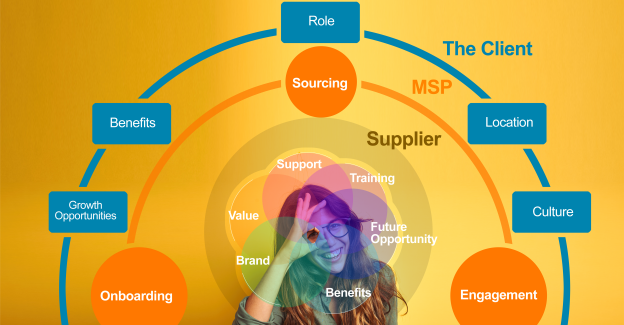Today’s talent landscape is becoming more driven by contingent workers; in some organizations, the number of contingent workers already outpaces full-time employees. It’s no surprise then that the pressure on talent suppliers to deliver is high. If staffing suppliers cannot facilitate successful placements at scale, then the revolving door of talent will continue to swing causing companies to waste time, money and resource on endless staffing. An immediate opportunity available to recruiting organizations and their managed service providers (MSPs) is to optimize the candidate experience.
The Strategic Importance of the Candidate Experience
We all know that first impressions matter. When it comes to talent, the recruiter is often the first point of contact for a potential contractor on behalf of an organization. Think about the discovery journey a candidate undergoes. When searching for a new role or project, he/she does research online, and then as a next step seeks to verify that by speaking to someone in the know (which, more often than not, is the recruiter). It is the recruiter who helps the candidate build trust in the employer brand. If the candidate has a bad experience with the recruiter or does not like what is heard, then most likely he/she will start considering other organizations. And in today’s competitive job market, with the most recent unemployment rate at 3.7%, that can be disastrous for hiring organizations.
To win the war for top talent, employers and those responsible for their candidate sourcing and onboarding need to ensure that their processes are candidate-centric with a positive experience. Today, the candidate experience begins at the job description or job ad since it’s the first exposure a candidate has to a potential position and employer, setting the tone for the entire candidate experience. It continues through the relationship with the recruiter, from the first time the candidate and the recruiter connect through the candidate journey. The recruiter acts as a filter for the client’s brand and the project’s value, which is then further analyzed by the candidate, using their own lens to judge. The supplier plays a very crucial role as brand ambassador for the companies they support, showcasing their client’s work culture, incentives, opportunities and more.
The Power of Influence
Joe Girard, who was recognized as the greatest salesmen ever by the Guinness Book of World Records, had a “law of 250”, by which he meant that if he did a poor job of dealing with someone, he could lose 250 more customers. He believed that was the number of people we could directly or indirectly influence, and this was before the Internet age! Imagine how many prospective candidates can be put off by one bad review on the web? As we know, today’s consumers place more emphasis on peer reviews than anything else.
So as a hiring organization, how much visibility and control do you have over the influence of your candidate experience? Do you know how your supplier base is representing you? Even though a contractor is employed for a specific role for a specific period of time, they also have a set of intrinsic goals that they want to achieve within that short-term assignment. The supplier has to be able to understand the candidates’ needs and desires from a role and then assess whether they will be a fit for the client:
- What part about the role can the candidate connect with?
- Is it meeting his/her expectations in terms of the challenges sought?
- Does it fit with the candidate’s desired career path?
- Does it offer opportunities for growth into the next role?
Realistically Improving the Candidate Experience
Unfortunately, this deep of a focus on the candidate is often far from the approach that is actually employed. Many recruiters reach out to candidates primarily based on their experience and skillset, simply matching job description to resume or profile rather than “selling” the candidate on the merits of the company or assignment. How many times have candidates left their assignment early because they did not like the client’s environment or because the project did not meet their expectations?
Here’s where an MSP can really add value. By strategically focusing on the candidate journey, there are multiple ways to realistically improve the candidate experience:
A consistent experience through multiple touchpoints
A candidate can end up speaking to three different sets of organizational cultures: the supplier, the MSP and the hiring organization. It is imperative that the candidate receives a consistent message about the opportunity and the company, along with a great experience at every touchpoint. The MSP can and should focus on this journey for the candidate, and work with the supplier regularly to make sure the supplier is up-to-date on any new initiatives at play with the client, and also hold the supplier responsible for ensuring the candidate recruitment journey is reflective of the employer brand. The MSP along with the supplier and the client must map out the candidate journey, right from the first email/call through the subsequent conversation to the onboarding.
The staffing supplier’s brand
The supplier’s reputation and processes are important. Candidates want to know whether this supplier will be able to help them find another role when this assignment comes to an end. Will they get training to bring their skills up to speed? Will they be paid on time? The best staffing agencies have their own brands that establish credibility, inspire confidence and entice talent to research their offerings further. By promoting an image that helps candidates identify and connect with them, they drive applicants to their job postings, translating in a more diverse and talented bench of candidates. Effective MSP programs look to engage with staffing suppliers who have brands that will lead to robust talent pipelines and relationships.
Constant communication & messaging
Most organizations are rapidly evolving in one form or another. Are the suppliers able to keep up with the changing value offerings and opportunities that your organization has to offer to candidates? To send the right message to the candidates, the MSP needs to collaborate with the supplier to ensure that the messaging to the candidates is refined and targeted every time. Refined so that it reflects the message you want to share with talent specifically, and targeted so that it shares the details of what the assignment requires in terms of skills and what it offers in terms of challenges and opportunities to potential candidates.
For MSPs seeking the highest quality talent for client programs, sourcing suppliers can be a challenging process. However, by seeking out and partnering with staffing suppliers who can champion and execute the desired candidate experience, customer-centric MSP can go a long way in helping to establish a great brand value proposition for a client; i.e. a targeted marketing campaign without any extra expenditure. Just keep in mind that candidates end up having a kaleidoscopic view of your organization, looking through the supplier’s and MSP’s mosaic, so be judicious about who you select to act as the stewards of your employer brand.
Region:







